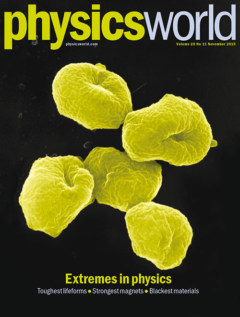Whether it’s the shortest wavelength, the lightest particle, the highest pressure or the brightest beam, there’s something intrinsically appealing about pushing boundaries to break records and establish new limits of what’s physically possible. Reaching new extremes is healthy for science too, spurring researchers to outperform rivals in the quest for grants, kudos or new jobs.
The November 2015 issue of Physics World, which is now out, covers three frontier-busting research endeavours. We kick off by looking at a human-made extreme: the search for the blackest materials ever produced – a tale that’s had a dark side of its very own. Next, we examine how physics techniques are unravelling the secrets of tough lifeforms that exist in some of the most extreme environments on Earth. Finally, we go beyond Earth to a cosmic extreme: magnetars – a special kind of rotating neutron star that are the strongest magnets in the universe.
If you’re a member of the Institute of Physics (IOP), you can get immediate access to this article in the digital edition of the magazine on your desktop via MyIOP.org or on any iOS or Android smartphone or tablet via the Physics World app, available from the App Store and Google Play. If you’re not yet in the IOP, you can join as an IOPimember for just £15, €20 or $25 a year to get full digital access to Physics World.

For the record, here’s run-down of the rest of the issue.
• Neutrino pioneers bag Nobel prize – Arthur McDonald and Takaaki Kajita share the 2015 Nobel Prize for Physics for discovering that neutrinos change flavours and therefore have mass, as Hamish Johnston reports
• Cooking Bacon – Few people have been as vilified as the philosopher, statesman and scientist Francis Bacon, argues Robert P Crease
• Nobel physics laureate migration – The movement of talented researchers across international borders has been the lifeblood of physics for more than a century. In these infographics, Hamish Johnston delves into the archives to discover which countries have gained the most physics Nobel laureates, and which have suffered the worst brain drains
• Fifty shades of black – Creating dark materials that prevent reflections has become hot competition recently, with Guinness World Records having to keep revising the darkest substance yet created. But depending on who’s asking, the best black may not be the blackest black, as Jon Cartwright discovers
• Surviving at the extremes – Wherever we look on Earth, even in the most inhospitable places, we find life. But how do organisms manage to survive such difficult conditions? Lorna Dougan explains how physicists are helping to unravel the properties of “extremophile” life
• The strongest magnets in the universe – On 27 December 2004 a blast of intense radiation overwhelmed NASA’s Swift telescope and Europe’s Integral craft. As Liz Kruesi explains, the light came from a star with the most powerful magnetic field ever seen
• Trafficking in big ideas – Arthur I Miller reviews Genius at Play: the Curious Mind of John Horton Conway by Siobhan Roberts
• A dark day for dinosaurs – Pete Edwards reviews Dark Matter and the Dinosaurs: the Astounding Interconnectedness of the Universe by Lisa Randall
• Fostering innovation – A cluster of independent consultancies has helped make Cambridge a hot spot in the UK’s hi-tech economy. Andrew Baker-Campbell describes what it’s like to be a part of this growing industry
• Once a physicst – Kevin Hollinrake, member of parliament for Thirsk and Malton, Yorkshire, UK
• Ant-Man and the quantum realm – Spiros Michalakis on his role as a Hollywood consultant



